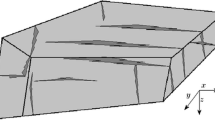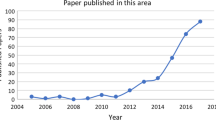Abstract
In this work we analyze the isothermal single-phase two-component non-Darcy flow in naturally fractured reservoirs (NFRs) for enhanced gas recovery (EGR) and carbon dioxide storage. The Peng–Robinson equation of state is used to evaluate the thermodynamic properties of the components, and the discretization of the governing partial differential equations is carried out using the Finite Volume Method, along with implicit and first-order upwind schemes. This process leads to a coupled non-linear algebraic system for the unknowns pressure and molar fractions. After linearization and use of an operator splitting, the Conjugate Gradient (CG) and the Biconjugate Gradient Stabilized (BCGS-Stab) methods are used to solve two algebraic subsystems, one for the pressure and another for the molar fraction. Non-Darcy effects are included using the Barree and Conway’s model for inertial effects. The numerical code also allows grid refinement to represent fractures and provides an improved capture of physical phenomena close to fractures. The effects of hydrodynamic dispersion in our simulations were also considered.















Similar content being viewed by others
References
Amao AM (2007) Mathematical model for Darcy–Forchheimer flow with applications to well performance analysis. Master’s thesis, Texas Tech University, Lubbock, Texas, USA
Audigane P, Chiaberge C, Mathurin F, Lions J, Picot-Colbeaux G (2011) A workflow for handling heterogeneous 3D models with the TOUGH2 family of codes: applications to numerical modeling of CO\(_2\) geological storage. Comput Geosci 37(4):610–620
Aziz K, Settari A (1979) Petroleum reservoir simulation. Applied Science Publishers LTD
Barenblatt G, Zheltov I, Kochina I (1960) Basic concepts in the theory of seepage of homogeneous liquids in fissured rocks [strata]. J Appl Math Mech 24(5):1286–1303
Barree RD, Conway MW (2004) A complete model for Darcy, Forchheimer, and Trans-Forchheimer flow in porous media. In: Society of Petroleum Engineers Annual Technical Conference and Exhibition, Houston, Texas, USA
Berghe G, Kline S, Burket S, Bivens L, Johnson D, Singh R (2019) Effect of CO\(_2\) and H\(_2\)O on the behavior of shale gas confined inside calcite [104] slit-like nanopore: a molecular dynamics simulation study. J Mol Model 25(9):293
Biryukov D, Kuchuk FJ (2012) Transient pressure behavior of reservoirs with discrete conductive faults and fractures. Transp Porous Media 95:239–268
Böttcher N, Singh AK, Kolditz O, Liedl R (2012) Non-isothermal, compressible gas flow for the simulation of an enhanced gas recovery application. J Comput Appl Math 236:4933–4943
Burrows LC, Haeri F, Cvetic P, Sanguinito S, Shi F, Tapriyal D, Goodman A, Enick RM (2020) A literature review of CO\(_2\), natural gas, and water-based fluids for enhanced oil recovery in unconventional reservoirs. Energy Fuels 34:5331–5380
Cavalcante Filho JSA, Sepehrnoori K (2017) Simulation of planar hydraulic fractures with variable conductivity using the embedded discrete fracture model. J Petrol Sci Eng 153:212–222
Chen Z (2007) Reservoir simulation—mathematical techniques in oil recovery. Society of Industrial and Applied Mathematics
Debossam JGS, dos Santos Heringer FD, de Souza G, Amaral Souto HP (2019) Numerical simulation of single-phase two-components flow in naturally fractured oil reservoirs. Coupled Syst Mech 8(2):129–146
Dybbs A, Edwards R (1984) A new look at porous media fluid mechanics—Darcy to turbulent, fundamentals of transport phenomena in porous media. NATO ASI Series (Series E: Applied Sciences), vol 82. Springer
Geiger S, Schmid KS, Zaretskiy Y (2012) Mathematical analysis and numerical simulation of multi-phase multi-component flow in heterogeneous porous media. Curr Opin Colloid Interface Sci 17:147–155
Gou Y, Hou ZM, Liu HJ, Zhou L, Were P (2014) Numerical simulation of carbon dioxide injection for enhanced gas recovery (CO\(_2\)-EGR) in Altmark natural gas field. Acta Geotech 9(1):49–58
Gou Y, Hou ZM, Li MT, Feng WT, Liu HJ (2016) Coupled thermo-hydro-mechanical simulation of CO\(_2\) enhanced gas recovery with an extended equation of state module for TOUGH2MP-FLAC3D. J Rock Mech Geotech Eng 8(6):904–920
Hamza A, Hussein IA, Al-Marri MJ, Mahmoud M, Shawabkeh R, Aparicio S (2021) CO\(_2\) enhanced gas recovery and sequestration in depleted gas reservoirs: a review. J Petrol Sci Eng 196:107685
Hosseini N, Bajalan Z, Khoei A (2020) Numerical modeling of density-driven solute transport in fractured porous media with the extended finite element method. Adv Water Resour 136:103453
Hoteit H, Firoozabadi A (2006) Compositional modeling of discrete-fractured media without transfer functions by the discontinuous Galerkin and mixed methods. SPE J 11(3):341–352
Hoteit H, Firoozabadi A (2018) Modeling of multicomponent diffusions and natural convection in unfractured and fractured media by discontinuous galerkin and mixed methods. Int J Numer Meth Eng 114(5):535–556
Hoteit H, Firoozabadi A (2005) Multicomponent fluid flow by discontinuous Galerkin and mixed methods in unfractured and fractured media. Water Resourc Res 41(11)
IBP (2023) Gás natural. Tech. rep., Instituto Brasileiro de Petróleo e Gás, https://www.ibp.org.br/
IPCC (2005) Special report on carbon dioxide capture and storage. Cambridge University Press, Cambridge
Jia B, Tsau JS, Barati R (2019) A review of the current progress of CO\(_2\) injection eor and carbon storage in shale oil reservoirs. Fuel 236:404–427
Jia Y, Shi Y, Pan W, Huang L, Yan J, Zhao Q (2019) The feasibility appraisal for CO\(_2\) enhanced gas recovery of tight gas reservoir: experimental investigation and numerical model. Energies 12:2225
Jiang J, Younis RM (2015) A multimechanistic multicontinuum model for simulating shale gas reservoir with complex fractured system. Fuel 161:333–344
Kalam S, Olayiwola T, Al-Rubaii MM, Amaechi BI, Jamal MS, Awotunde AA (2021) Carbon dioxide sequestration in underground formations: review of experimental, modeling, and field studies. J Petrol Explor Prod Technol 11:303–325
Kim TH, Cho J, Lee KS (2017) Evaluation of CO\(_2\) injection in shale gas reservoirs with multi-component transport and geomechanical effects. Appl Energy 190:1195–1206
Lai B, Miskimins JL, Wu YS (2009) Non-Darcy porous media flow according to the Barree and Conway’s model: laboratory and numerical modeling studies. In: Society of Petroleum Engineers Rocky Mountain Petroleum Technology Conference, Denver, Colorado, USA
Lee SH, Lough MF, Jensen CL (2001) Hierarchical modeling of flow in naturally fractured formations with multiple length scales. Water Resour Res 37(3):443–455
Li D, Robert K, Engler TW, Grigg RB (2001) Modeling and simulation of wafer non-Darcy flow experiments. In: Society of Petroleum Engineers Western Regional Meeting, Bakersfield, California, USA
Liu J, Xie LZ, He B, Gan Q, Zhao P (2021) Influence of anisotropic and heterogeneous permeability coupled with in-situ stress on CO\(_2\) sequestration with simultaneous enhanced gas recovery in shale: Quantitative modeling and case study. Int J Greenhouse Gas Control 104:103208
Liu SY, Agarwal R, Sun BJ, Wang B, Li HY, Xu JC, Fu GM (2021) Numerical simulation and optimization of injection rates and wells placement for carbon dioxide enhanced gas recovery using a genetic algorithm. J Clean Prod 180:124512
Lohrenz J, Bray BG, Clark CR (1964) Calculating viscosities of reservoir fluids from their compositions. J Petrol Technol 16(10):1171–1176
Maes J, Muggeridge AH, Jackson MD, Quintard M, Lapene A (2016) Modelling in-situ upgrading of heavy oil using operator splitting method. Comput Geosci 20:581–594
Mohagheghian E, Hassanzadeh H, Chen ZX (2019) CO\(_2\) sequestration coupled with enhanced gas recovery in shale gas reservoirs. J CO2 Util 34:646–655
Moinfar A (2013) Development of an efficient embedded discrete fracture model for 3D compositional reservoir simulation in fractured reservoirs. PhD thesis, The University of Texas at Austin, Austin, Texas, USA
Moyne C, Didierjean S, Amaral Souto HP, da Silveira OT (2000) Thermal dispersion in porous media: one-equation model. Int J Heat Mass Transf 43:3853–3867
Nelson R (2001) Geologic analysis of naturally fractured reservoirs, 2nd edn. Gulf Professional Publishing
Oldenburg CM, Stevens SH, Benson SM (2004) Economic feasibility of carbon sequestration with enhanced gas recovery (CSEGR). Energy 29:1413–1422
Ramasomanana F, Fahs M, Baalousha HM, Barth N, Ahzi S (2018) An efficient ellam implementation for modeling solute transport in fractured porous media. Water, Air, Soil Pollut 229(46):1–22
Saad Y (2003) Iterative methods for sparse linear systems, 2nd edn. Society of Industrial and Applied Mathematics
Saira Janna F, Le-Hussain F (2020) Effectiveness of modified CO\(_2\) injection at improving oil recovery and CO\(_2\) storage—review and simulations. Energy Rep 6:1922–1941
Sandve T, Berre I, Nordbotten J (2012) An efficient multi-point flux approximation method for discrete fracture-matrix simulations. J Comput Phys 231(9):3784–3800
Secchi S, Schrefler BA (2012) A method for 3-D hydraulic fracturing simulation. Int J Fract 178:245–258
Sim SSK, Turta AT, Singhal AK, Hawkins BF (2009) Enhanced gas recovery: factors affecting gas-gas displacement efficiency. J Can Pet Technol 48(8):49–55
Singh AK, Goerke UJ, Kolditz O (2011) Numerical simulation of non-isothermal compositional gas flow: application to carbon dioxide injection into gas reservoirs. Energy 36(5):3446–3458
Singh AK, Baumann G, Henninges J, Gorke UJ, Kolditz O (2012) Numerical analysis of thermal effects during carbon dioxide injection with enhanced gas recovery: a theoretical case study for the Altmark gas field. Environ Earth Sci 67(2):497–509
Souza G, Amaral Souto HP (2016) A comparative study of non-darcy flows in naturally fractured gas reservoirs. J Braz Soc Mech Sci Eng 38(6):1701–1715
Tiab D, Donaldson EC (2004) Petrophysics, theory and practice of measuring reservoir rock and fluid transport properties, 2nd edn. Gulf Professional Publishing
Vennemo S (2016) Multiscale simulation of thermal flow in porous media. Master’s thesis, Norwegian University of Science and Technology, Trondheim, Norway
Versteeg HK, Malalasekera W (2007) An introduction to computational fluid dynamics: the finite, vol method. Pearson, London
Wang L, Tian Y, Yu X, Wang C, Yao B, Wang S, Winterfeld PH, Wang X, Yang Z, Cui YWJ, Wu YS (2017) Advances in improved/enhanced oil recovery technologies for tight and shale reservoirs. Fuel 210:425–445
Warren JE, Root PJ (1963) The behavior of naturally fractured reservoirs. Soc Petrol Eng J 3(3):245–255
Wu Y, Sun S (2016) Equivalence of two models in single-phase multicomponent flow simulations. Comput Math Appl 7:1303–1316
Zeng F, Zhao G (2008) Semianalytical model for reservoirs with Forchheimer’s non-darcy flow. Soc Petrol Eng Reserv Eval Eng 11:280–291
Zhang RH, Wu JF, Zhao YL, He X, Wang RH (2021) Numerical simulation of the feasibility of supercritical CO\(_2\) storage and enhanced shale gas recovery considering complex fracture networks. J Petrol Sci Eng 204:108671
Zhao P, Xie LZ, He B, Liu J (2020) Strategy optimization on industrial CO\(_2\) sequestration in the depleted Wufeng-Longmaxi formation shale in the northeastern Sichuan Basin, SW China: from the perspective of environment and energy. ACS Sustain Chem Eng 8(30):11435–11445
Zhou X, Yuan Q, Peng X, Zenga F, Zhang L (2018) A critical review of the CO\(_2\) huff ‘n’ puff process for enhanced heavy oil recovery. Fuel 215:813–824
Zidane A, Firoozabadi A (2014) An efficient numerical model for multicomponent compressible flow in fractured porous media. Adv Water Resour 74:127–147
Zidane A, Firoozabadi A (2017) Fracture-cross-flow equilibrium in compositional two-phase reservoir simulation. SPE J 22(3):1–21
Acknowledgements
The authors gratefully thanks Rio de Janeiro State University, Coordination for the Improvement of Higher Education Personnel (CAPES)—Finance Code 001, and National Council for Scientific and Carlos Chagas Filho Foundation for Research Support of the State of Rio de Janeiro (FAPERJ) for their support.
Author information
Authors and Affiliations
Corresponding author
Ethics declarations
Conflict of interest
There are no undeclared competing interests or funding.
Additional information
Publisher's Note
Springer Nature remains neutral with regard to jurisdictional claims in published maps and institutional affiliations.
Rights and permissions
Springer Nature or its licensor (e.g. a society or other partner) holds exclusive rights to this article under a publishing agreement with the author(s) or other rightsholder(s); author self-archiving of the accepted manuscript version of this article is solely governed by the terms of such publishing agreement and applicable law.
About this article
Cite this article
Souza Debossam, J.G., de Souza, G., Amaral Souto, H.P. et al. Numerical simulation of single-phase two-component non-Darcy flow in naturally fractured reservoirs for enhanced gas recovery and carbon dioxide storage. Braz. J. Chem. Eng. 41, 197–219 (2024). https://doi.org/10.1007/s43153-023-00318-x
Received:
Revised:
Accepted:
Published:
Issue Date:
DOI: https://doi.org/10.1007/s43153-023-00318-x
Keywords
- Carbon dioxide storage
- Compositional flow
- Barree and Conway’s model
- Finite volume method
- Naturally fractured reservoir
- Non-Darcy flow




